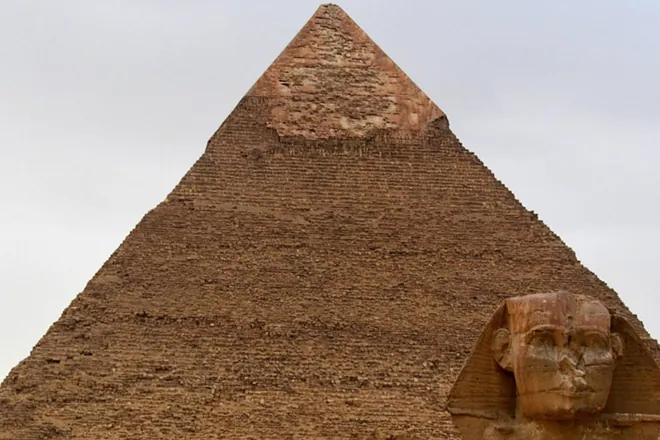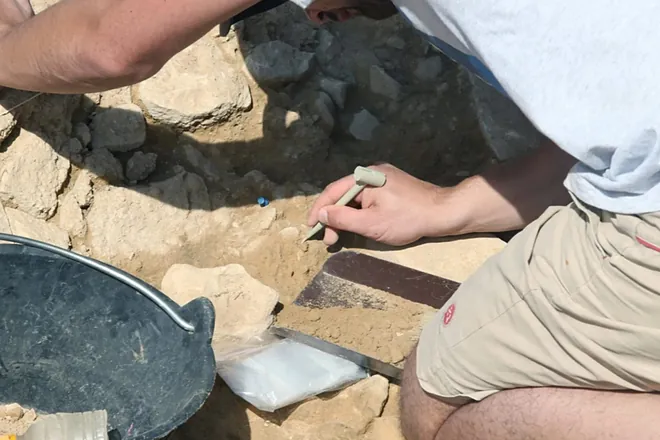In the vast timeline of human history, few civilizations captivate us like ancient Egypt. With its towering pyramids, enigmatic hieroglyphs, and god-like pharaohs, Egypt has long been seen as a cradle of innovation rising from the Nile’s fertile banks. But what if the story we’ve pieced together from tombs and temples is missing a crucial chapter? A recent DNA analysis of a 4,500-year-old skeleton is challenging our understanding, revealing deep ties between Egypt and distant Mesopotamia that could reshape how we view the birth of one of the world’s greatest empires.

This isn’t just another archaeological find—it’s a genetic bombshell that confirms what historians have suspected for years: ancient civilizations weren’t isolated islands but interconnected webs of people, ideas, and innovations. Let’s dive into the details of this groundbreaking discovery and what it means for rewriting Egyptian history.
The Discovery: Unearthing a Potter’s Past
Imagine a skeleton tucked away in a museum drawer for over a century, holding secrets that could bridge continents. Excavated between 1902 and 1904 from the Nuwayrat necropolis—about 265 kilometers south of Cairo—this adult male lived during Egypt’s Early Dynastic or early Old Kingdom period, roughly 2855–2570 BCE. That’s the era when the first pyramids were emerging, marking the dawn of Egypt’s golden age.
Buried in a simple ceramic pot, a common funerary practice of the time, the man was likely in his late 50s or 60s at death—an impressive lifespan for the Bronze Age. Standing about 157–160 cm tall, with brown eyes, brown hair, and dark to black skin, his bones tell a story of hard labor. Osteoarthritis, enlarged bones from repetitive stress, and signs of a diet rich in wheat, barley, animal protein, and Nile fish paint him as a craftsman, possibly a potter. Isotope analysis of his teeth confirms he grew up right there in the Nile Valley.
But the real magic happened in the lab. Researchers extracted high-quality DNA from the petrous bone in his inner ear—a dense spot that preserves genetic material remarkably well, even in Egypt’s scorching climate. This yielded the oldest and most complete genome from ancient Egypt to date, opening a window into his ancestry that spans millennia.
DNA Revelations: From the Nile to Mesopotamia
The genome analysis, published last month, is nothing short of revolutionary. Here’s what it uncovered:
- Dominant North African Roots: About 78% of his DNA links back to Neolithic populations from modern-day Morocco, dating to 4,780–4,230 BCE. This aligns with the local North African heritage that formed the backbone of early Egyptian society.
- A Surprising Mesopotamian Link: The remaining 22% traces to Neolithic Mesopotamia—present-day Iraq and surrounding areas—from around 9,000–8,000 BCE. That’s over 1,500 kilometers away, across deserts and seas. This is the first genetic evidence of such admixture in an ancient Egyptian individual.
His maternal lineage (mitochondrial DNA) belongs to haplogroup I/N1a1b2, and his paternal line (Y-chromosome) to E1b1b1b2b~, both prevalent in North Africa and West Asia. Comparisons with later Egyptian genomes show evolving influences: by 787–544 BCE, there’s more Levantine (eastern Mediterranean) ancestry, and modern Egyptians carry even broader mixes, including from sub-Saharan regions like Ethiopia and the Congo.
No significant DNA from sub-Saharan Africa or other far-flung areas was found in this man, suggesting the Mesopotamian influence arrived via early migrations or gene flow during the Neolithic period. Likely routes? Trade paths along the Mediterranean or Red Sea coasts, rather than a grueling overland trek through the Sinai.
Archaeologists have long noted cultural parallels between Egypt and Mesopotamia—shared inventions like the pottery wheel, early writing systems (cuneiform in Mesopotamia around 3200 BCE, hieroglyphs in Egypt soon after), and agricultural techniques. But until now, we had no biological proof that people were crossing these distances, carrying not just goods and ideas, but their very genes.
Expert Voices: Bridging Genetics and History
This study, led by an international team including Adeline Morez Jacobs (formerly of Liverpool John Moores University), Pontus Skoglund (Francis Crick Institute, London), and Linus Girdland-Flink (Liverpool John Moores University and University of Liverpool), involved collaborators from the World Museum Liverpool and beyond.
As Skoglund told the BBC, “If we get more information about the DNA and compare it with what we know from the archaeological, cultural and written information we have from the time, it will be very exciting.” Morez Jacobs echoed this optimism: “We hope that future ancient Egyptian DNA samples will expand the information on when exactly this movement began from Western Asia and what its extent was.” She added in interviews that while archaeologists believed Egypt and Mesopotamia exchanged ideas—evidenced by similar advancements in writing and technology—we now have confirmation of human contact.
These insights highlight how genetics can fill in the blanks left by artifacts and texts, painting a fuller picture of ancient mobility.
What This Means for Ancient Egyptian History
Does this “rewrite” history? Not entirely—it’s more like adding vibrant color to a black-and-white sketch. Egypt’s unification under pharaohs and its architectural marvels were fueled by local ingenuity, but this DNA shows external influences played a role. The 22% Mesopotamian ancestry points to gene flow starting in the 6th millennium BCE, coinciding with the spread of farming and domesticated animals across the Fertile Crescent.
It challenges outdated views of Egypt as a hermetically sealed society, emphasizing instead a melting pot where North African, West Asian, and later Levantine peoples mingled. This exchange likely accelerated progress: Mesopotamia’s urban innovations meeting Egypt’s Nile-based agriculture could have sparked the rapid rise of dynastic power.
Looking ahead, more genomes from this era could reveal timelines of migration, social dynamics, and even potential conflicts. It’s a reminder that human history is a tapestry of connections—Egypt and Mesopotamia weren’t rivals in isolation but partners in shaping civilization.
A Novelty That Turns the Established Order on Its Head
As the article that sparked this discussion aptly put it, this is “a novelty that promises to turn the established order on its head.” Scientific explorations like this don’t just uncover bones; they resurrect stories of our shared past, showing how migration and mixing have always driven human evolution.
If you’re as fascinated by ancient mysteries as I am, keep an eye on upcoming studies—they might just unlock more secrets from the sands. What do you think: Could this change how we teach Egyptian history in schools? Share your thoughts in the comments!
Sources: This post draws from the original research published in Nature and reports from outlets like the BBC and Live Science.







